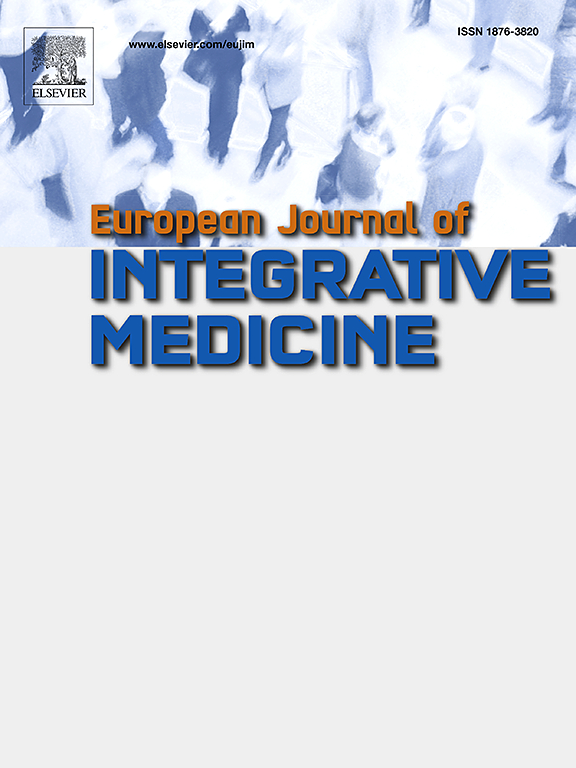Comparing moxibustion strategies in rheumatoid arthritis: A systematic review and network meta-analysis
IF 1.7
4区 医学
Q3 INTEGRATIVE & COMPLEMENTARY MEDICINE
引用次数: 0
Abstract
Introduction
Rheumatoid arthritis (RA) is a highly prevalent chronic autoimmune disease worldwide. Moxibustion has increasingly been used in clinical practice as an effective treatment for RA. However, more comprehensive evidence is needed to determine optimal moxibustion strategies for RA management and guide clinical interventions.
Methods
This review conducted a literature search across eight databases, including PubMed, Embase, Web of Science, Cochrane Library, VIP, CBM, Wanfang Database, and CNKI. The Cochrane Risk of Bias tool 2 was used to assess the quality of the selected studies. Network meta-analysis (NMA) was conducted using R Studio 4.2.2 and STATA 17.0.
Results
A total of 78 clinical trials with 5896 participants were included. The relative efficacy of nine moxibustion therapies was assessed. NMA data revealed that compared with conventional therapy (CVT, including Disease-modifying Antirheumatic Drugs, Nonsteroidal Anti-inflammatory Drugs, and glucocorticoids), heat-sensitive moxibustion plus CVT showed promising effects for clinical response (RR = 1.45, 95 % CI: 1.08, 2.06) and disease activity score 28 (DAS-28; mean difference [MD] = −0.98, 95 % CI: −1.81, −0.15). Moxa cone moxibustion (MCM) plus CVT was more effective than suspending moxibustion plus CVT in DAS-28 (MD = −0.48, 95 % CI: −0.83, −0.09). For the visual analog scale, MCM plus CVT was the most effective (MD = −1.59, 95 % CI: −2.08, −1.11), more effective than warm needle moxibustion (WNM) plus CVT (MD = −0.93, 95 % CI: −1.81, −0.05) and direct moxibustion plus CVT (MD = −1.49, 95 % CI: −2.81, −0.19). Indirect moxibustion (IM) plus CVT was most effective in reducing morning stiffness time (MD = −22.76, 95 % CI: −36.31, −7.23). WNM plus CVT and governor vessel moxibustion (GVM) plus CVT showed greater effects in reducing swollen joint count (MD = −2.37, 95 % CI: −3.23, −1.54) and lowering rheumatoid factor (MD = −0.68, 95 % CI: −1.58, 0.22). In reducing C-reactive protein, IM plus CVT was most effective (MD = −6.60, 95 % CI: −9.55, −3.95). GVM plus CVT had the lowest adverse reaction rate (3.33 %).
Conclusion
This NMA provides robust evidence supporting the combination of multiple moxibustion therapies with traditional RA treatments. Moxibustion may alleviate various RA symptoms. However, longer-term, high-quality, reproducible, multicenter randomized controlled trials with larger sample sizes are necessary to confirm these results and establish optimal treatment strategies.
比较艾灸治疗类风湿关节炎的策略:系统综述和网络荟萃分析
类风湿性关节炎(RA)是一种在世界范围内高度流行的慢性自身免疫性疾病。艾灸作为治疗类风湿性关节炎的有效方法已越来越多地应用于临床。然而,需要更全面的证据来确定RA治疗的最佳艾灸策略并指导临床干预。方法采用PubMed、Embase、Web of Science、Cochrane Library、VIP、CBM、万方数据库、中国知网等8个数据库进行文献检索。使用Cochrane偏倚风险工具2来评估所选研究的质量。使用R Studio 4.2.2和STATA 17.0进行网络meta分析(NMA)。结果共纳入78项临床试验,5896名受试者。比较九种艾灸疗法的相对疗效。NMA数据显示,与常规治疗(CVT,包括改善疾病的抗风湿药、非甾体抗炎药和糖皮质激素)相比,热敏灸加CVT在临床疗效上有很好的效果(RR = 1.45, 95% CI: 1.08, 2.06),疾病活动性评分28分(DAS-28;平均差[MD] = - 0.98, 95% CI: - 1.81, - 0.15)。在DAS-28中,艾灸加CVT比悬灸加CVT更有效(MD = - 0.48, 95% CI: - 0.83, - 0.09)。在视觉模拟量表上,MCM + CVT最有效(MD = - 1.59, 95% CI: - 2.08, - 1.11),优于温针灸(WNM) + CVT (MD = - 0.93, 95% CI: - 1.81, - 0.05)和直接灸+ CVT (MD = - 1.49, 95% CI: - 2.81, - 0.19)。间接灸(IM)加CVT对减少晨僵时间最有效(MD = - 22.76, 95% CI: - 36.31, - 7.23)。WNM + CVT和GVM + CVT在减少肿胀关节计数(MD = - 2.37, 95% CI: - 3.23, - 1.54)和降低类风湿因子(MD = - 0.68, 95% CI: - 1.58, 0.22)方面效果更好。在降低c反应蛋白方面,IM + CVT最有效(MD = - 6.60, 95% CI: - 9.55, - 3.95)。GVM联合CVT的不良反应发生率最低(3.33%)。结论本研究为艾灸综合疗法与传统RA治疗相结合提供了有力证据。艾灸可以缓解各种RA症状。然而,需要更长期、高质量、可重复、多中心、大样本量的随机对照试验来证实这些结果并建立最佳治疗策略。
本文章由计算机程序翻译,如有差异,请以英文原文为准。
求助全文
约1分钟内获得全文
求助全文
来源期刊

European Journal of Integrative Medicine
INTEGRATIVE & COMPLEMENTARY MEDICINE-
CiteScore
4.70
自引率
4.00%
发文量
102
审稿时长
33 days
期刊介绍:
The European Journal of Integrative Medicine (EuJIM) considers manuscripts from a wide range of complementary and integrative health care disciplines, with a particular focus on whole systems approaches, public health, self management and traditional medical systems. The journal strives to connect conventional medicine and evidence based complementary medicine. We encourage submissions reporting research with relevance for integrative clinical practice and interprofessional education.
EuJIM aims to be of interest to both conventional and integrative audiences, including healthcare practitioners, researchers, health care organisations, educationalists, and all those who seek objective and critical information on integrative medicine. To achieve this aim EuJIM provides an innovative international and interdisciplinary platform linking researchers and clinicians.
The journal focuses primarily on original research articles including systematic reviews, randomized controlled trials, other clinical studies, qualitative, observational and epidemiological studies. In addition we welcome short reviews, opinion articles and contributions relating to health services and policy, health economics and psychology.
 求助内容:
求助内容: 应助结果提醒方式:
应助结果提醒方式:


